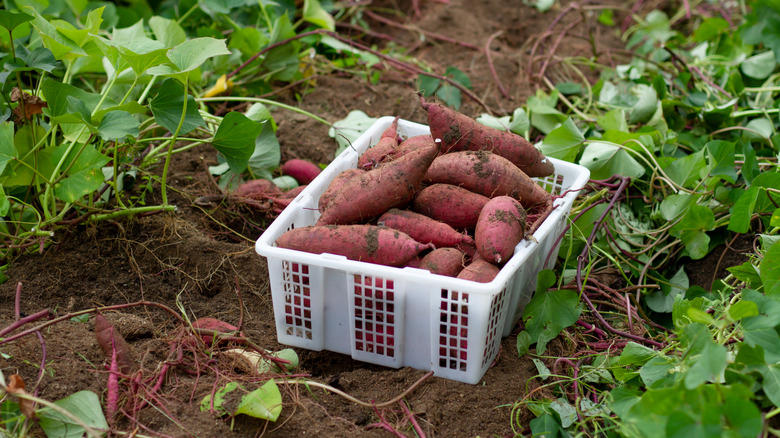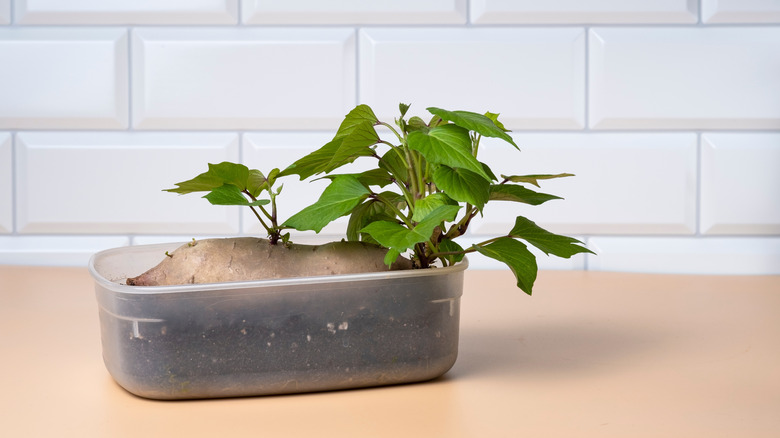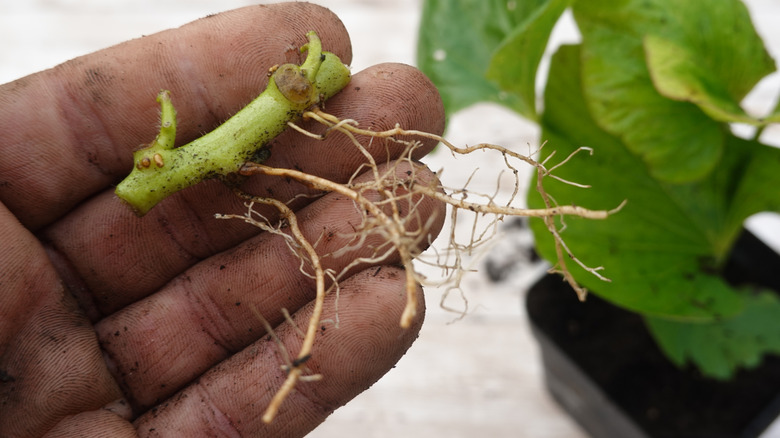How To Propagate Sweet Potatoes Indoors So You Can Enjoy Them Year-Round
Do you wish you could skip trips to the grocery store and just reach into your pantry for sweet potatoes? When you think of propagating vegetables, you probably imagine the sunshine and warm soil of a greenhouse or outdoor grow box. However, bringing this root vegetable indoors lets you grow it year-round — so long as you live in the right location. While the sweet potato (Ipomoea batatas) is typically grown as a summer annual in many parts of the U.S., it's perennial in USDA Hardiness Zones 10 through 11. Where temperatures stay consistently warm, you can start the vegetable indoors at home. Then, you can grow it all year — either in the garden or by following the best way to grow sweet potatoes in containers outdoors or indoors in a sunny location. Start your sweet potato by growing slips, which are the leaves and branches that sprout from the tuber.
Because the slips take some time to grow to a good size, February is the right time to start sweet potatoes. Choose a firm, unblemished, and ideally locally grown sweet potato for propagation. Smaller tubers about 2 inches in diameter work well. The sprouting process requires a warm environment, which tells the sweet potato to start growing shoots. Check in advance that you have somewhere in your home that stays about 75 to 85 degrees Fahrenheit with high humidity. For example, you could place a sprouting sweet potato on the top of your refrigerator or on a seedling heat mat. You'll also need either some sturdy toothpicks and a glass, vase, or jar full of water or a container and moist potting soil. The latter method is faster.
Sprouting sweet potatoes to grow slips
Getting your first sweet potato slips requires carefully managing the tuber's exposure to heat and moisture. Fill a shallow aluminum tray or small container with moist soil. Lay the sweet potato on its side and bury it about halfway into the soil. Once you have your sweet potato nestled in the moist soil, cover the container with plastic wrap or a plastic dome to help keep the humidity high. This jumpstarts the sprouting process and prevents the potato from drying out. If you chose instead to suspend the tuber in water using toothpicks pressed into the side, change the water every few days to prevent the potato from rotting. Then, regardless of the setup you use, place your sprouting sweet potato in your pre-determined warm location and wait.
Within two to four weeks for the soil method and six to eight weeks for the suspension method, you should start to see green sprouts (the sweet potato slips) growing from the top of the potato. Once you have a few healthy-looking sweet potato slips, let them grow until they're about 5 or 6 inches tall. At this point, they are ready to be removed from the potato. You can gently twist them off or use clean scissors to cut them from the soil or the surface of the potato. These removed sprouts will eventually become your outdoor, year-round sweet potato crop. Side note: You can use either process to regrow sweet potatoes from the grocery store.
Transitioning sprouted slips to pots for year-round harvest
The removed sweet potato slips need time to develop roots before being planted in a container or garden bed. Take the newly separated slips and remove a few leaves from the bottom. Place the stem into a jar of fresh water. Sit the jar in a sunny window or under a grow light. In just a couple of days, you should see small white roots forming. Freshen the water once a week and throw away or compost dead slips. Once the new roots on your healthy slips reach several inches long, the seedlings are ready for their permanent home indoors or out.
Plant each rooted slip into a 15 to 20 gallon planter or garden bed filled with loose, well-draining soil. Since you want the plant to produce large edible tubers, choose a full sun spot. Inside, this could be a south-facing window. Alternatively, you can supplement a lack of sunlight with grow lights. Use a fertilizer that's low in nitrogen to encourage large tubers. Depending on the variety of sweet potato and your specific growing conditions, you can expect to harvest edible tubers in about 90 to 120 days after planting the rooted slips. When it's harvest time, upturn the planter or gently cut and remove the vines from the garden bed before removing the tubers. Then, start some slips on a few new sweet potatoes to keep the year-round cycle going.


